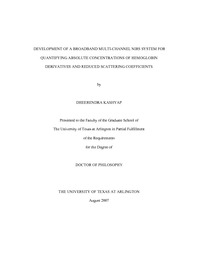
ATTENTION: The works hosted here are being migrated to a new repository that will consolidate resources, improve discoverability, and better show UTA's research impact on the global community. We will update authors as the migration progresses. Please see MavMatrix for more information.
Show simple item record
| dc.contributor.author | Kashyap, Dheerendra | en_US |
| dc.date.accessioned | 2008-08-08T02:31:01Z | |
| dc.date.available | 2008-08-08T02:31:01Z | |
| dc.date.issued | 2008-08-08T02:31:01Z | |
| dc.date.submitted | August 2007 | en_US |
| dc.identifier.other | DISS-1807 | en_US |
| dc.identifier.uri | http://hdl.handle.net/10106/897 | |
| dc.description.abstract | Near infrared spectroscopy (NIRS) has been widely applied to investigate hemoglobin oxygenations of muscles, brain and breast tumors. Steady state reflectance techniques developed previously have been restricted to determination of relative concentrations. To overcome these limitations, this dissertation describes the development, validation and applications of broadband, steady-state, optical spectroscopic systems and algorithms to quantify absolute concentrations of hemoglobin derivatives and reduced light scattering coefficients using (1) thin optical probes with small (100 μm - 1 mm) source-detector separations and (2) a large separation (< 4 cm) probe..
A recently developed mathematical model by Zonios and Dimou for reflectance at small source-detector separations was used to develop techniques to quantify chromophore concentrations and light scattering coefficients (Chap. 2). Blood-intralipid phantom models were used to determine empirical coefficients to model reflectance spectra. This technique was further applied to quantify hemodynamic changes during formalin- induced pain behaviors in rats (Chap. 3).
To overcome limitations in penetration depth and investigated tissue volume, another approach to quantify concentrations of chromophores in tissues at large source-detector separations was also developed. This novel approach uses the process of second differential spectroscopy to quantify concentrations of deoxygenated hemoglobin with respect to the tissue water content. Based on such quantification, an adaptation of the ant colony optimization algorithm was utilized to quantify absolute concentrations of other constituent tissue chromophores. The developed techniques were validated with the reflectance measurements from blood-intralipid phantoms and further applied to monitoring of ex vivo human prostate lesions and of rat brain tumor growth in vivo (Chap. 4).
In the second stage of my doctoral development, a multi-channel, broadband, steady-state, NIRS imaging system was developed to determine spatial distributions of hemoglobin concentrations and reduced light scattering coefficients. The imager was calibrated with laboratory phantoms to eliminate deterministic instrumentation bias of CCD-spectrometers, optical fibers, and multiplexer channels. Calibration procedures also include determinations of the source strength and boundary coefficients in order to obtain accurate image reconstructions. A multi-wavelength, spectrally constrained reconstruction algorithm was developed to obtain tomographic maps of hemoglobin derivative concentrations and reduced scattering coefficients, using laboratory tissue phantoms. The developed imaging system and reconstruction algorithms were validated with both static and dynamic multi-tube phantoms. | en_US |
| dc.description.sponsorship | Liu, Hanli | en_US |
| dc.language.iso | EN | en_US |
| dc.publisher | Biomedical Engineering | en_US |
| dc.title | Development Of A Broadband Multi-channel NIRS System For Quantifying Absolute Concentrations Of Hemoglobin Derivatives And Reduced Scattering Coefficients | en_US |
| dc.type | Ph.D. | en_US |
| dc.contributor.committeeChair | Liu, Hanli | en_US |
| dc.degree.department | Biomedical Engineering | en_US |
| dc.degree.discipline | Biomedical Engineering | en_US |
| dc.degree.grantor | University of Texas at Arlington | en_US |
| dc.degree.level | doctoral | en_US |
| dc.degree.name | Ph.D. | en_US |
| dc.identifier.externalLink | https://www.uta.edu/ra/real/editprofile.php?onlyview=1&pid=28 | |
| dc.identifier.externalLinkDescription | Link to Research Profiles | |
Files in this item
- Name:
- umi-uta-1807.pdf
- Size:
- 2.550Mb
- Format:
- PDF
This item appears in the following Collection(s)
Show simple item record


